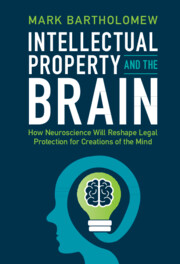 Intellectual Property and the Brain
Intellectual Property and the Brain from Part II - Understanding Audiences for Art and Advertising
Published online by Cambridge University Press: 14 July 2022
Design patents are meant to promote designs that are “pleasing,” “attractive,” and “beautiful.” Yet judges fret that they will inject their own prejudices into such aesthetic determinations and have adopted a permissive nonobviousness standard that only rejects designs when they are exact copies of what came before. Neuroscience sheds light on the mechanics of design perception and appreciation. Visual processing is arguably the best understood mental process in modern neuroscience. Recent studies show that aesthetic preference is strongly tied to the ease with which an observer can mentally process a particular design. Although a limited amount of innovation may be needed to gain the observer’s attention, consumers insist on simplicity, familiarity, and congruence in designs. Rather than correlating with what an audience considers pleasing, innovation in design, after rapidly reaching an optimal level, begins to trigger aesthetic distaste. I use a variety of examples from popular products and actual cases—like Herman Miller’s Aeron chair and Lego blocks—to illustrate this audience preference for designs in the “aesthetic middle.”
To save this book to your Kindle, first ensure no-reply@cambridge.org is added to your Approved Personal Document E-mail List under your Personal Document Settings on the Manage Your Content and Devices page of your Amazon account. Then enter the ‘name’ part of your Kindle email address below. Find out more about saving to your Kindle.
Note you can select to save to either the @free.kindle.com or @kindle.com variations. ‘@free.kindle.com’ emails are free but can only be saved to your device when it is connected to wi-fi. ‘@kindle.com’ emails can be delivered even when you are not connected to wi-fi, but note that service fees apply.
Find out more about the Kindle Personal Document Service.
To save content items to your account, please confirm that you agree to abide by our usage policies. If this is the first time you use this feature, you will be asked to authorise Cambridge Core to connect with your account. Find out more about saving content to Dropbox.
To save content items to your account, please confirm that you agree to abide by our usage policies. If this is the first time you use this feature, you will be asked to authorise Cambridge Core to connect with your account. Find out more about saving content to Google Drive.